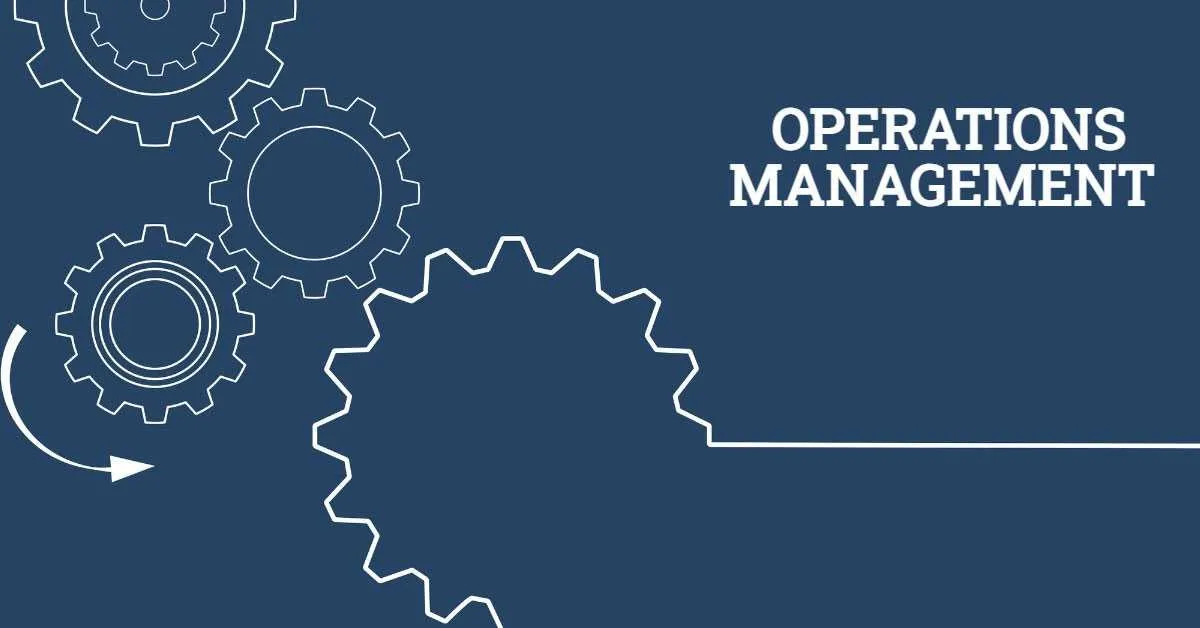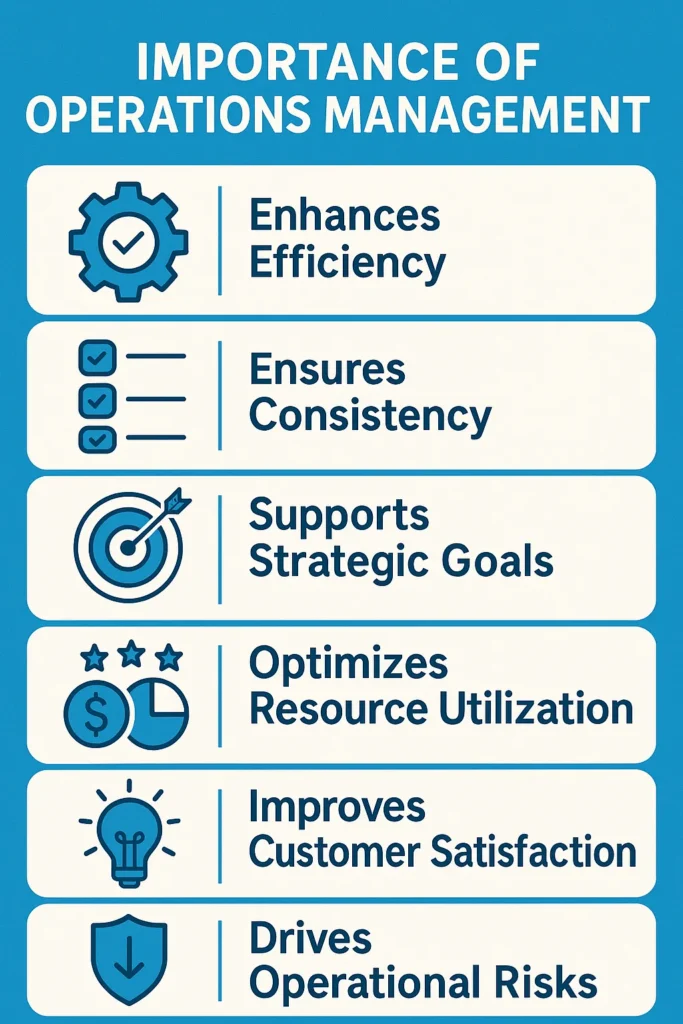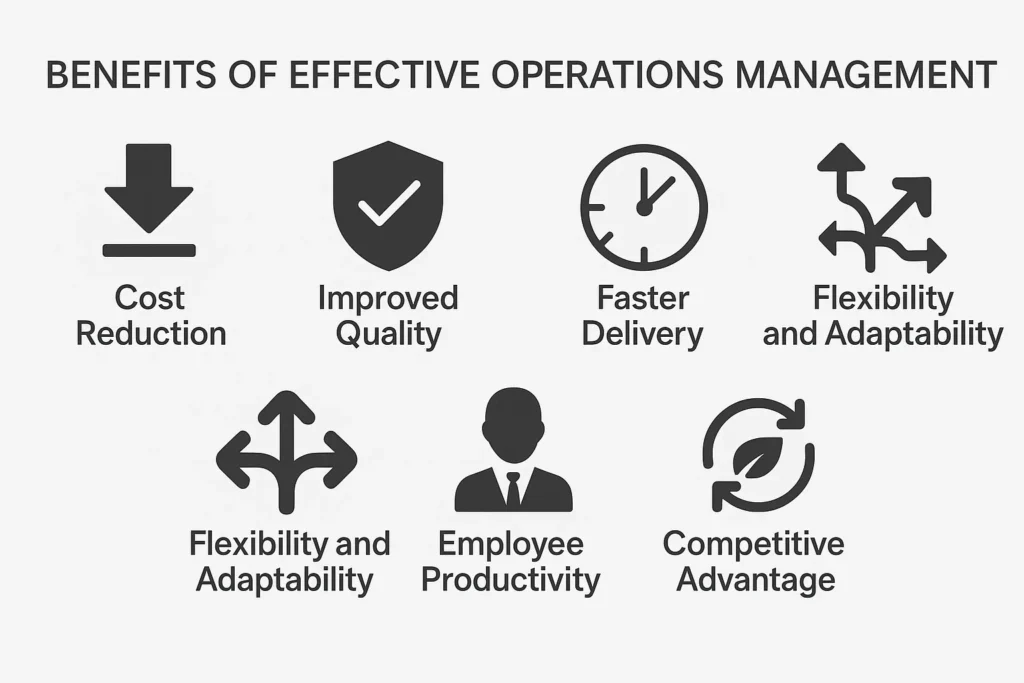
Executive Summary
Operations management (OM) is a core discipline in business that focuses on designing, overseeing, and controlling the processes that produce goods and services. It ensures that an organization’s operations are efficient, cost-effective, and capable of delivering high-quality products or services consistently.
Operations management involves planning, organizing, coordinating, and controlling resources—people, technology, and materials—to meet customer demand while maximizing productivity and minimizing costs. This guide explores the concept of operations management, its functions, techniques, benefits, challenges, strategies, and real-world applications across industries.
Table of Content
Introduction
In the competitive business landscape of today, operations management is more than just overseeing production. It is a strategic function that integrates process design, resource management, supply chain coordination, quality control, and continuous improvement.
Operations management serves as the backbone of an organization. It ensures that products are manufactured on time, services are delivered efficiently, and organizational goals are achieved with maximum resource utilization. Whether in manufacturing, healthcare, retail, or service sectors, operations management is crucial to business success.
Core Concepts of Operations Management
Operations management revolves around several key principles that guide organizations in delivering products and services effectively:
- Process Design and Optimization – Structuring workflows to ensure smooth, efficient operations.
- Capacity Planning – Balancing production capacity with demand to avoid shortages or overproduction.
- Resource Management – Allocating people, materials, and equipment efficiently.
- Quality Management – Ensuring products and services meet established standards.
- Inventory Management – Maintaining optimal stock levels to reduce cost while meeting demand.
- Supply Chain Coordination – Managing relationships with suppliers, distributors, and customers.
- Continuous Improvement – Implementing strategies like Lean and Six Sigma to enhance processes.
Key Functions of Operations Management
Operations management encompasses a broad range of activities that contribute to organizational efficiency:
1. Product and Service Design
- Developing products or services that meet customer needs.
- Incorporating feedback to enhance quality and usability.
- Considering cost-effectiveness, sustainability, and scalability.
2. Process Design and Workflow Management
- Mapping and optimizing operational processes for efficiency.
- Identifying bottlenecks and implementing solutions to improve throughput.
- Utilizing technology and automation to streamline operations.
3. Capacity Planning
- Estimating production requirements based on demand forecasts.
- Allocating resources to prevent underutilization or overloading.
- Adjusting capacity for seasonal fluctuations and market trends.
4. Supply Chain Management
- Coordinating with suppliers, manufacturers, warehouses, and distributors.
- Managing procurement, logistics, and inventory to ensure timely delivery.
- Enhancing collaboration and communication across the supply chain.
5. Inventory and Materials Management
- Implementing strategies like Just-in-Time (JIT) to optimize inventory levels.
- Monitoring raw materials, work-in-progress, and finished goods.
- Reducing waste and storage costs while ensuring product availability.
6. Quality Control and Assurance
- Conducting inspections and audits to maintain product standards.
- Utilizing Total Quality Management (TQM) and ISO certifications.
- Implementing corrective actions to minimize defects and customer complaints.
7. Operations Planning and Scheduling
- Developing production schedules that align with demand forecasts.
- Coordinating work shifts, machine usage, and resource allocation.
- Using software tools to optimize scheduling and reduce downtime.
8. Performance Measurement and Improvement
- Tracking key performance indicators (KPIs) like cycle time, throughput, and efficiency.
- Conducting root cause analysis to resolve operational challenges.
- Implementing continuous improvement initiatives to enhance productivity.
Further Your Learning: Operations Management Course
Elevate your understanding of operations with this targeted course that covers how to structure, analyze and optimise workflows, capacity, and resources — all essential for efficient operations in any business.
Importance of Operations Management
Operations management is vital for several reasons:

- Enhances Efficiency – Streamlined processes reduce costs and maximize output.
- Ensures Consistency – High-quality products and services meet customer expectations.
- Supports Strategic Goals – Aligns operational activities with business objectives.
- Optimizes Resource Utilization – Makes the best use of labor, materials, and technology.
- Improves Customer Satisfaction – Timely delivery and quality assurance build loyalty.
- Drives Innovation – Encourages process improvements and adoption of new technologies.
- Reduces Operational Risks – Proper planning and monitoring minimize disruptions and losses.
Techniques and Approaches in Operations Management
Modern operations management relies on various techniques to improve efficiency and effectiveness:
1. Lean Management
- Focuses on eliminating waste and optimizing value-added processes.
- Utilizes tools like value stream mapping and 5S methodology.
2. Six Sigma
- A data-driven approach to reduce defects and improve quality.
- Uses DMAIC (Define, Measure, Analyze, Improve, Control) methodology.
3. Total Quality Management (TQM)
- Continuous focus on quality improvement at every stage of operations.
- Encourages employee involvement and customer-centric processes.
4. Just-in-Time (JIT)
- Inventory strategy that reduces holding costs and improves cash flow.
- Ensures materials and products are available exactly when needed.
5. Capacity Requirement Planning (CRP)
- Determines resources needed to meet production targets.
- Helps balance demand and capacity to prevent bottlenecks.
6. Enterprise Resource Planning (ERP)
- Integrates core business processes across departments using software solutions.
- Facilitates data-driven decision-making and operational efficiency.
7. Benchmarking
- Compares operations with industry standards or competitors.
- Identifies best practices to enhance performance.
8. Forecasting and Demand Planning
- Uses historical data and market trends to predict demand.
- Guides production scheduling, inventory management, and capacity planning.
Tools and Technologies in Operations Management
Operations management increasingly relies on digital tools to optimize processes:
- ERP Systems: SAP, Oracle NetSuite, Microsoft Dynamics
- Inventory Management Tools: TradeGecko, Zoho Inventory, Fishbowl
- Supply Chain Management Software: Kinaxis, Manhattan Associates, Llamasoft
- Production Planning Tools: Asprova, Preactor, GanttPRO
- Quality Management Software: MasterControl, ETQ, Greenlight Guru
- Project Management Tools: Trello, Monday.com, Smartsheet
- Analytics and Reporting Platforms: Tableau, Power BI, QlikView
Real-World Applications of Operations Management
Operations management is applicable across various industries:
- Manufacturing – Managing production lines, supply chains, and quality control.
- Retail and E-commerce – Optimizing inventory, logistics, and customer fulfillment.
- Healthcare – Coordinating hospital operations, patient care, and medical supplies.
- Hospitality and Tourism – Streamlining hotel operations, reservations, and service delivery.
- Banking and Finance – Improving transaction processes, compliance, and operational efficiency.
- Construction and Engineering – Planning projects, resources, and timelines effectively.
- IT and Technology Services – Managing software development processes and service delivery.
Benefits of Effective Operations Management
Effective operations management provides significant advantages:

- Cost Reduction – Streamlined processes reduce waste and operational expenses.
- Improved Quality – Consistent product and service standards enhance customer satisfaction.
- Faster Delivery – Efficient scheduling and logistics improve time-to-market.
- Flexibility and Adaptability – Quick response to changes in demand or market conditions.
- Employee Productivity – Clear processes and workflow planning enhance staff efficiency.
- Competitive Advantage – Optimized operations position businesses ahead of competitors.
- Sustainability – Resource-efficient processes reduce environmental impact.
Challenges in Operations Management
Despite its importance, operations management faces various challenges:
- Globalization – Managing international supply chains with differing regulations.
- Technological Change – Integrating new tools without disrupting operations.
- Demand Fluctuations – Predicting and responding to volatile market demand.
- Supply Chain Disruptions – Managing risks from suppliers, natural disasters, or geopolitical events.
- Workforce Management – Ensuring skilled labor availability and training.
- Sustainability and Compliance – Meeting environmental and regulatory standards.
- Cost Management – Balancing efficiency with investments in quality and technology.
Key Metrics and KPIs in Operations Management
Operations performance is measured through specific indicators:
- Cycle Time – Time taken to complete a process or produce a product.
- Throughput – Quantity of products or services delivered in a specific period.
- Utilization Rate – Extent to which resources are effectively used.
- Inventory Turnover – Frequency of inventory replacement in a period.
- On-Time Delivery – Percentage of products or services delivered on schedule.
- Cost per Unit – Average cost incurred to produce a unit of product or service.
- Customer Satisfaction (CSAT) – Feedback on product or service quality.
- Defect Rate – Percentage of products not meeting quality standards.
Future Trends in Operations Management
The field of operations management is evolving rapidly with global trends and technological advancements:

- Automation and AI – Robotics and artificial intelligence for process optimization.
- Data Analytics and Big Data – Predictive insights to improve operations and forecasting.
- Sustainable Operations – Emphasis on eco-friendly production and resource efficiency.
- Agile Operations – Flexible processes that can adapt quickly to market changes.
- Integration of IoT – Smart devices for real-time monitoring and process control.
- Blockchain for Supply Chains – Enhancing transparency and traceability.
- Remote and Cloud Operations – Managing operations digitally across multiple locations.
Common Misconceptions
- Operations Management is Only for Manufacturing – It applies to services, healthcare, IT, and more.
- OM Is Only About Cost Cutting – While efficiency is important, quality and customer satisfaction are equally critical.
- Technology Alone Solves Operational Challenges – Human planning and decision-making remain essential.
- Operations Managers Only Supervise Production – They strategically plan, analyze, and optimize all processes.
Steps to Effective Operations Management
- Assess Current Processes – Map workflows and identify inefficiencies.
- Set Operational Goals – Align objectives with organizational strategy.
- Plan Resources – Allocate labor, materials, and technology effectively.
- Implement Technology Solutions – Use ERP, SCM, and quality management tools.
- Monitor Performance – Track KPIs and identify areas for improvement.
- Optimize Continuously – Apply Lean, Six Sigma, and TQM for ongoing process enhancement.
- Engage Employees – Train staff, promote collaboration, and encourage feedback.
- Adapt to Change – Be flexible to evolving market conditions, customer needs, and technology.
Operations management connects closely with several other disciplines that focus on efficiency, productivity, and strategic coordination.
- To explore how overall business structures support operational success, read What Is Business Management?.
- For insights into process improvement and leadership, check out What Is Project Management? and The Ultimate Guide to Change Management.
- Operations often depend on people and performance — learn more in What Is Human Capital Management (HCM)? and What Is Performance Management?.
- Finally, for a deeper look at how processes and data drive decisions, explore What Is Knowledge Management?.
Conclusion
Operations management is a critical discipline that ensures organizations produce goods and deliver services efficiently, effectively, and consistently. By optimizing resources, streamlining processes, managing supply chains, and implementing continuous improvement, operations management drives profitability, customer satisfaction, and long-term success.
With advancements in technology, globalization, and sustainability, operations management continues to evolve, playing a strategic role in helping organizations adapt, compete, and thrive in dynamic markets.


